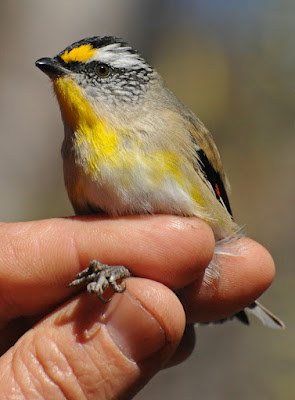Striated Pardalote Pardalotus ornatus
Over the weekend I was out helping Mark Clayton banding birds with his long-term bird-banding project at Charcoal Tank Nature Reserve near West Wyalong. The study site is in western New South Wales, in a remnant of once extensive woodland growing on the western plains.
Striated Pardalote Pardalotus striatus, with a yellow wing spot
It is still early Spring and many migrants are on their return flights home to their respective breeding grounds after spending winter elsewhere. And one of the birds we caught and banded was of a race of Striated Pardalote Pardalotus striatus, which only breeds in Tasmania, but overwinters within the range of two other races of Striated pardalote. On the same day in the same place, we also caught and banded pardalotes of the eastern race, P. ornatus, which only breeds in south-east Australia. The distinguishing feature between them is the colour of their wing spots - coloured tips to their greater primary coverts. In the Tasmanian race they are yellow, and in the Eastern race they are red.
Striated Pardalote Pardalotus ornatus, with a red wing spot
Striated Pardalote Pardalotus striatus, showing the yellow tips to
the primary coverts which merge when folded to form the wingspot,
and a single narrow white stripe on the seventh primary.
(Pardalotes only have nine primaries).
The study site sits on the boundary between the range of the P. ornatus race and that of the very similar race P. substriatus, which breeds in west and central Australia. The two races described above have only a narrow white wingstripe on the outer web of one primary feather (p7), while the P. substriatus race has a wide stripe over several primary feathers (p3-7). See the report for September 20 2011 for comparison with these. Click on this link to go directly there. Pardalote substriatus










